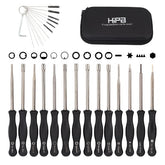The Ultimate Guide to Engine Compression Testing: 2-Stroke vs. 4-Stroke
Is your engine losing power? Hard to start? Or maybe you're just doing routine maintenance? A compression test is one of the most valuable and straightforward diagnostics you can perform. It tells you the health of your engine's core—the pistons, rings, cylinders, and valves.
But here's the catch: testing a 2-stroke engine is different from testing a 4-stroke, and if you don't know why, you can easily be misled by your own tools!
In this guide, we'll walk you through testing both engine types and solve the mystery of why your compression tester sometimes "lies" about a 4-stroke engine.
Part 1: How to Test a 2-Stroke Engine (The Simple, Yet Critical, Check)
A 2-stroke engine is simpler in design—it has no mechanical valves in the cylinder head. This makes the test more direct, but the results are no less critical.
What You'll Need:
· A compression tester with the correct adapter for your spark plug hole.

· A socket set (to remove the spark plug).

· A friend (optional, but helpful).
The Step-by-Step Guide:
Warm Up the Engine: A quick run-up to operating temperature ensures all metal components have expanded, giving you a more accurate "real-world" reading.
Safety First! Disconnect the spark plug wire and ground it to the engine casing to prevent any accidental starts.
Remove the Spark Plug: Take out the spark plug completely.

Secure the Tester: Screw the compression tester adapter firmly into the spark plug hole by hand. Ensure you have a good seal.

Hold the Throttle Open: This is crucial. Have a helper hold the throttle wide open, or if you're alone, wedge it open. This allows the engine to draw in the maximum amount of air for the test.
Crank the Engine: Now, pull the starter rope (or use the electric starter) vigorously 5-7 times. You should see the needle on the gauge climb with each pull. Stop once the needle stops rising.
Record the Reading: Note the highest pressure achieved (in PSI or BAR).
Interpreting Your 2-Stroke Results:
Healthy (New/Rebuilt): 120-150 PSI or more. This indicates strong, healthy rings and a good seal.
Acceptable (Used but Fine): 100-120 PSI. The engine should still run well.
Worn Out: Below 90-100 PSI. This indicates significant wear on the piston, rings, or cylinder. The engine will be hard to start and lack power.
The Most Important Number: The Difference. Test all cylinders (if a multi-cylinder engine). They should be within 10% of each other. A significant difference points to a problem isolated to one cylinder.
Part 2: The 4-Stroke Mystery & How to Solve It
You've followed the steps above on your 4-stroke lawn mower or motorcycle engine, and the gauge reads a dismal 60 PSI. Before you tear the engine apart, stop! Your tester might not be broken—it might just be fooled by an engineering cleverness.
Why Your Compression Tester "Doesn't Work" on Some 4-Strokes
The culprit is almost always a Compression Release Mechanism.

What is it? A small device, usually built into the camshaft, that temporarily holds an exhaust valve slightly open during the compression stroke when the engine is cranking at low speed.
What is it? A small device, usually built into the camshaft, that temporarily holds an exhaust valve slightly open during the compression stroke when the engine is cranking at low speed.
How does it break your test? Since the valve is open, air escapes, and your compression tester records a falsely low reading. Once the engine starts and reaches a certain RPM, the centrifugal mechanism disengages, and the valve closes normally, giving you full compression for running.
How to Test a 4-Stroke Engine (The Right Way)
The process is similar to a 2-stroke, but with one critical adjustment to defeat the compression release.
What You'll Need:
*(Same as for the 2-stroke)*
The Step-by-Step Guide (The "Bump & Jump" Method):
Follow Steps 1-5 from the 2-stroke guide: Warm up the engine, ensure safety, remove the spark plug, and screw in the tester. Hold the throttle wide open.
Crank & Observe Carefully: This is the key difference. As you crank the engine, watch the gauge closely.
You will see the needle quickly "bump" up to a low number (e.g., 50-80 PSI) and seem to stop. DO NOT STOP CRANKING.
Continue cranking. After a few more revolutions, you should see the needle suddenly "jump" to a much higher, final reading.
Record the FINAL Reading: Note the pressure the gauge stabilizes at after the jump. This is your true compression reading.
Troubleshooting: If the pressure never jumps and stays consistently low, then you have a genuine problem (worn rings, burnt valves, etc.).
Interpreting Your 4-Stroke Results:
Healthy Engine: Final reading of 120-180 PSI (varies greatly by engine). The key is the strong "jump."
Follow Steps 1-5 from the 2-stroke guide: Warm up the engine, ensure safety, remove the spark plug, and screw in the tester. Hold the throttle wide open.
Crank & Observe Carefully: This is the key difference. As you crank the engine, watch the gauge closely.
You will see the needle quickly "bump" up to a low number (e.g., 50-80 PSI) and seem to stop. DO NOT STOP CRANKING.
Continue cranking. After a few more revolutions, you should see the needle suddenly "jump" to a much higher, final reading.
Record the FINAL Reading: Note the pressure the gauge stabilizes at after the jump. This is your true compression reading.
Troubleshooting: If the pressure never jumps and stays consistently low, then you have a genuine problem (worn rings, burnt valves, etc.).
Interpreting Your 4-Stroke Results:
Healthy Engine: Final reading of 120-180 PSI (varies greatly by engine). The key is the strong "jump."
Low & No Jump: A consistently low reading (e.g., 70 PSI) that never climbs indicates the engine can't build pressure, pointing to mechanical wear.
The 10% Rule Still Applies: For multi-cylinder engines, compare the final readings. They should be close.
Summary & Pro Tip
|
Engine Type |
Key Difference |
Healthy PSI Range (Approx.) |
|
2-Stroke |
Simple test; no compression release. |
100-150+ PSI |
|
4-Stroke |
Look for the "bump & jump" to defeat the compression release. |
120-180+ PSI |
Pro Tip: The Leakdown Test
If you're still unsure, a professional-grade diagnostic is a leakdown test. Instead of measuring pressure build-up, it measures pressure loss. It pressurizes the cylinder at top-dead-center and tells you exactly where the air is escaping (rings, intake valve, or exhaust valve), completely bypassing the compression release issue.
Conclusion
Don't let a low compression reading on your 4-stroke engine send you on a wild goose chase. Remember the "bump & jump" method to outsmart the compression release mechanism. For 2-strokes, the test is more straightforward, but the results are just as critical.
Armed with this knowledge and a reliable compression tester, you can confidently diagnose the heart of your engine and get back to the project at hand.
Happy wrenching!






















